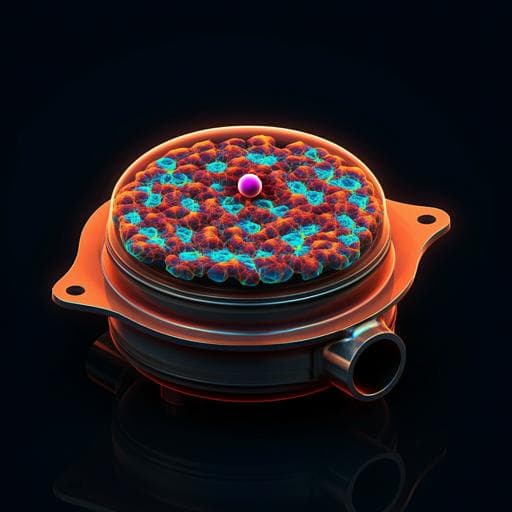
Chemistry
A single site ruthenium catalyst for robust soot oxidation without platinum or palladium
Y. Li, T. Qin, et al.
This study introduces an innovative and cost-effective Ru₁/CeO₂ catalyst, showcasing remarkable performance and stability in soot oxidation, comparable to traditional Pt-based catalysts. Conducted by Yuanfeng Li, Tian Qin, and their team, this research paves the way for more accessible catalytic technologies.
~3 min • Beginner • English
Introduction
Auto-exhaust soot is a major atmospheric pollutant, motivating the use of particulate filters combined with oxidation catalysts to promote soot removal at lower temperatures. Although numerous catalysts have been explored, commercial systems predominantly rely on Pt and Pd, driving up costs and supply dependence. Ruthenium is more economical, but Ru-based catalysts for automotive applications have been limited by volatility of Ru oxides at elevated temperatures. Strong metal–support interactions (SMSI), particularly with ceria (CeO₂), are known to enhance both activity and thermal stability in soot oxidation. Single-atom catalysts (SACs) offer maximal metal utilization and uniform active sites; however, designing thermally robust and intrinsically active Ru single-atom sites that operate effectively at the complex three-phase interface of soot oxidation remains challenging. CeO₂ is an excellent cocatalyst due to its oxygen storage/release properties and capacity to modulate metal sites via interfacial interactions and facet effects. Building on prior work with Ce-based supports and facet-optimized precious metal catalysts, this study aims to create and understand a Ru single-atom catalyst anchored in the surface lattice of CeO₂ that can replace Pt/Pd for efficient, stable soot oxidation.
Literature Review
Prior studies highlight: (i) strong Ru–CeO₂ interactions can improve activity and thermal stability for soot oxidation via SMSI; (ii) precious metal single-atom catalysts provide high atomic efficiency and well-defined active sites but face design challenges for three-phase soot reactions; (iii) CeO₂ supports, especially with controlled crystal facets, enhance oxygen activation and catalyst stability owing to excellent oxygen storage/release properties; (iv) Pt/Pd remain the core of commercial soot oxidation catalysts, contributing to high costs and supply dependence; (v) volatility of Ru oxides at high temperature is a key barrier to practical Ru catalysts; and (vi) interfacial site architecture and electronic interactions govern both performance and durability in oxidation catalysis. Despite advances, reports on single-atom Ru anchored at surface lattice sites of single-crystal CeO₂ and their application to soot oxidation are limited, motivating the present work.
Methodology
Catalyst synthesis: Nanoflower-like CeO₂ microspheres (CeO₂-M) were prepared hydrothermally using glucose, acrylamide, cerium nitrate, and ammonia, followed by calcination in N₂ and air. Conventional CeO₂ nanoparticles (CeO₂-C) were prepared by deposition–precipitation. Single-atom Ru on CeO₂ (Ru₁/CeO₂) was synthesized via a gas bubbling-assisted membrane deposition (GBMD) method: CeO₂-M was dispersed in water, RuCl₃·3H₂O and PVP were added, and ammonia solution was introduced through a membrane reactor to deposit Ru species, followed by washing, drying, and calcination (500 °C, 4 h, air). Ru nanoparticle catalyst (Ruₙ/CeO₂) was prepared similarly by gas bubbling-assisted membrane reduction using higher Ru precursor loading and NaBH₄ as reductant, followed by calcination.
Characterization: ICP-OES measured Ru loadings; XRD determined phases (cubic fluorite CeO₂); XPS probed Ru oxidation states and O 1s, Ce 3d; XANES/EXAFS at Ru K-edge assessed Ru coordination and valence; SEM/TEM/STEM-ADF and EDX mapping examined morphology and Ru dispersion; N₂ physisorption assessed surface area and porosity; Raman probed lattice/defect features and Ru–O–Ce signatures; H₂-TPR evaluated reducibility/active oxygen; in-situ DRIFTS examined CO adsorption (site identification) and NO oxidation intermediates; UV–Vis monitored SPR changes post-reaction.
Catalytic testing: Soot oxidation was evaluated by temperature-programmed oxidation (TPO) using Printex-U soot under loose or tight contact. Feed: 5 vol% O₂, 0.2 vol% NO in Ar, total 50 mL min⁻¹; heating 150–550 °C at 2 °C min⁻¹. CO and CO₂ were monitored online. Performance metrics included T₁₀/T₅₀/T₉₀, CO₂ selectivity, TOF (isothermal at 280 °C in kinetic regime), and apparent activation energy via Coats–Redfern. Time-on-stream TOF and six-cycle recyclability were assessed.
DFT calculations: VASP with PBE-GGA and DFT+U (Ueff = 5 eV for Ce 4f). CeO₂(110) slabs (2×4) with 15 Å vacuum; bottom two layers fixed. Single-atom Ru modeled by substituting a surface-layer Ce atom; Ru nanoparticle model contained 10 Ru atoms. Adsorption/desorption energies computed; CI-NEB used for transition states. Bader charge analysis and charge density differences assessed interfacial charge transfer and O₂ activation.
Key Findings
- Structure and dispersion: Ru loadings were 0.46 wt.% (Ru₁/CeO₂) and 3.80 wt.% (Ruₙ/CeO₂). XRD showed only CeO₂ phases; EXAFS revealed atomically dispersed Ru in Ru₁/CeO₂ with a sole Ru–O peak (1.49 Å). Fitting gave Ru–O coordination number ~5.3 with bond length 2.01 Å, consistent with a Ru₁O₅ site occupying CeO₂ surface lattice positions; Ruₙ/CeO₂ showed Ru–O and Ru–O–Ru features (CN ~3.4, 2.04 Å). XPS/NEXAFS indicated Ru in Ru₁/CeO₂ is positively charged with a valence > +4; Ruₙ/CeO₂ contained mixed Ru⁰/Ruⁿ species.
- Site identification: CO-DRIFTS on Ru₁/CeO₂ showed a strong band at 2057 cm⁻¹ (Ru¹⁺(CO)₂ on single atoms) and features near 2018/1991 cm⁻¹, while Ruₙ/CeO₂ exhibited weak bridged CO bands at 1830/1860 cm⁻¹ indicative of sub-nanometric particles. STEM-ADF and EDX confirmed homogeneously dispersed single Ru atoms on CeO₂.
- Stability: After six soot-TPO cycles, Ru₁/CeO₂ maintained oxidized Ru species and lattice-confined single-atom structure (Raman), while Ruₙ/CeO₂ showed increased RuO₂ (~323 cm⁻¹), decreased defect ratio (I_D/I_G), and UV–Vis SPR red-shift, indicating Ru aggregation and weakened interaction.
- Active oxygen and defects: Raman showed increased defect-induced signals and Ru–O–Ce features (~682 and ~975 cm⁻¹). Ru₁/CeO₂ had the highest defect density (ID/IF₂g). O 1s XPS quantified the highest fraction of active oxygen species (superoxide/peroxide) for Ru₁/CeO₂ at ~37%. Ce 3d XPS showed the largest Ce³⁺ fraction (27.6%) for Ru₁/CeO₂, evidencing strong Ru–O–Ce electronic interaction and more CUC sites. H₂-TPR showed stronger Ru–support interaction for Ru₁/CeO₂ (Ru reduction at 173 °C vs 127 °C for Ruₙ/CeO₂) and >13× higher low-temperature active oxygen availability vs bare CeO₂-M.
- NO oxidation and NO₂-assisted soot oxidation: NO markedly enhanced soot oxidation, with a larger T₅₀ decrease upon NO addition for Ru₁/CeO₂ (ΔT₅₀ = 87 °C) than for Ruₙ/CeO₂ (ΔT₅₀ = 54 °C). NO-TPO showed Ru₁/CeO₂ generated higher NO₂ concentrations with a lower peak temperature (305 °C) than Ruₙ/CeO₂ (315 °C). In-situ DRIFTS revealed evolution from nitrites/nitrates to labile NO₃⁻ intermediates and NO₂; Ru₁/CeO₂ had the largest NO₃⁻ intensity at 200 °C.
- Catalytic performance: Ru₁/CeO₂ delivered a turnover frequency TOF_Ru = 0.218 h⁻¹ and apparent activation energy Ea = 75.2 kJ mol⁻¹ for soot oxidation, outperforming Ru nanoparticles (TOF_Ru = 0.023 h⁻¹; ~9× lower) and commercial Pt-based catalysts. CO₂ selectivity exceeded 99% with excellent durability over extended operation and multiple cycles.
- DFT insights: Single-atom Ru donated more charge to CeO₂ (1.46 e⁻) than Ru₁₀ SNPs (1.26 e⁻), strengthening CUC formation and O₂ activation (greater charge transfer to adsorbed O₂). Key steps in NO oxidation showed lower barriers and easier NO₂ desorption for Ru₁/CeO₂ vs Ru₁₀/CeO₂: O₂ activation/NO₂ formation barrier 0.90 eV (Ru₁) vs 1.23 eV (Ru₁₀); NO₂ desorption energies 1.01 and 1.70 eV (Ru₁) vs 2.60 and 2.15 eV (Ru₁₀) for successive cycles. The rate-determining step is formation of NO₂* at the Ru–CeO₂ interface; facile NO₂ generation promotes the NO₂-assisted soot oxidation pathway.
Discussion
The study addresses the challenge of replacing Pt/Pd in soot oxidation by engineering robust, atomically dispersed Ru sites embedded in the surface lattice of CeO₂. The Ru₁O₅ single sites create strong Ru–O–Ce interactions that increase coordinatively unsaturated cation (CUC) sites, elevate active oxygen species, and enhance NO and O₂ activation. Mechanistically, in-situ DRIFTS and DFT reveal that the Ru–CeO₂ interface promotes the formation of labile nitrate intermediates and lowers the barrier for NO oxidation to NO₂, the rate-determining step in the NO₂-assisted soot oxidation cycle. Easier NO₂ desorption from single-atom Ru sites sustains rapid turnover, explaining the substantially higher TOF and lower apparent activation energy compared to Ru nanoparticles and commercial Pt-based catalysts. The single-atom configuration also confers superior thermal and structural stability under reaction conditions, resisting Ru volatility and aggregation that typically plague Ru-based systems. Collectively, these findings demonstrate that precise atomic-site construction on CeO₂ can decouple activity and durability limitations, enabling a cost-effective alternative to Pt/Pd for exhaust soot abatement.
Conclusion
Embedding single-atom Ru in the surface lattice of CeO₂ via GBMD produces a Ru₁O₅ active site with strong interfacial charge transfer, high densities of active oxygen and CUC sites, and superior NO/O₂ activation. This architecture accelerates the NO₂-forming, rate-determining step in NO oxidation, thereby enhancing NO₂-assisted soot oxidation. Ru₁/CeO₂ achieves TOF_Ru = 0.218 h⁻¹, Ea = 75.2 kJ mol⁻¹, CO₂ selectivity >99%, and excellent durability, outperforming Ru nanoparticle and commercial Pt-based catalysts. The work provides a practical pathway to reduce reliance on Pt/Pd by using a less costly precious metal in a single-atom form stabilized by strong metal–support interactions. Future research can extend this lattice-anchored SAC design to other supports/facets and reactions involving activated O₂ and deep oxidation to further optimize activity, stability, and scalability for automotive after-treatment.
Limitations
Related Publications
Explore these studies to deepen your understanding of the subject.







